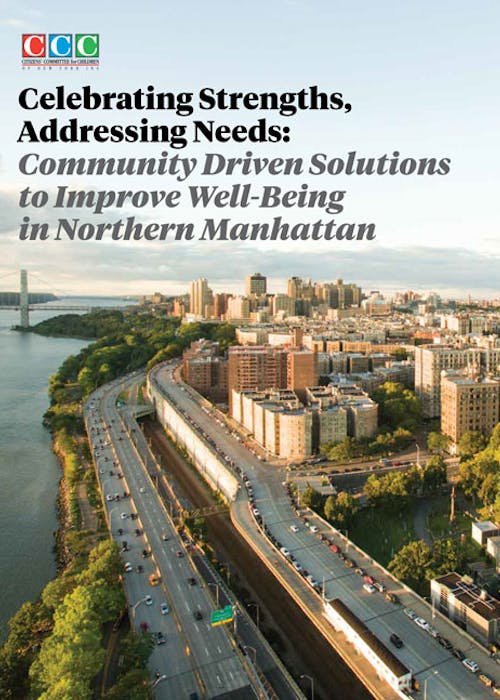

Celebrating Strengths, Addressing Needs: Community Driven Solutions To Improve Well-Being In Northern Manhattan
Data Resources
May 4, 2018
This report outlines recommendations to address inequalities and relieve the stressors exacerbated by gentrification in Northern Manhattan. It is the result of a year-long assessment of child and family needs in Washington Heights, Central Harlem and West Harlem, gathered through analysis of government data and information collected through focus groups and interviews with service providers, parents and youth.
Northern Manhattan has experienced progress in recent years that sets the region ahead of citywide advancements – with greater than citywide decreases in the rate of uninsured children and teen birth rates and increases in average household incomes. These gains have not been experienced by all residents, however, and worrisome outcomes persist related to poverty, housing stability and education, particularly for black and Latino families.
In northern Manhattan, inequality between racial/ethnic groups in terms of income and opportunities for upward mobility is even greater than it is citywide:
- Black households have much lower average incomes in northern Manhattan than they do citywide ($44,000 citywide; between $34,000 and $39,000 in northern Manhattan).
- Over 40% of Latinos in West Harlem and Washington Heights lack a high school diploma, compared to one-third of Latinos citywide.
- In northern Manhattan, the poverty rate for black residents is 30%, 18 percentage points higher than for white residents (12%). Citywide, the poverty rate for black residents is 21% percent, only nine points higher than for white residents (12%).
- In northern Manhattan, 76% of three- and four-year-olds in higher income households are enrolled in an early education program, compared to 53% of those in poor households, a 23 percentage point difference. Citywide, the difference in early education enrollment between higher income and poor households is 17 percentage points (73% versus 56%).
In addition to disparities in income, children and families in northern Manhattan communities experience a number of risks to well-being:
- Nearly 1 out of 4 16- to 24-year-olds in Central Harlem is out of school and out of work, the second highest rate out of 59 community districts.
- Fifteen percent of Washington Heights households – including over 20% of Latino households – are overcrowded, meaning there is more than one resident per room. In Central Harlem, the number of families entering homeless shelter rose to 5.8 in 2015 which is significantly higher than the citywide rate of 3.8
- Central Harlem has the second lowest life expectancy out of 59 community districts in the city, and has among the poorest outcomes on a range of health indicators, including having the third highest infant mortality rate in the city, and high rates of child asthma and alcohol and drug related hospitalizations.
- In each northern Manhattan neighborhood (with the exception of Morningside Heights) pass rates on state-mandated English Language Arts and Math exams are below the citywide average.
- Nearly 40 percent of residents in Washington Heights are limited English speakers, and in nearly a quarter of households, no one over the age of 14 speaks English “very well.”
Through CCC’s participatory research, community residents and service providers identified several recommendations to improve upward mobility, housing stability and well-being in Northern Manhattan, including but not limited to:
- Both caregivers and youth seek opportunities to be economically secure and upwardly mobile. Service providers and residents recommended creating greater access to financial literacy, economic empowerment and entrepreneurship resources for all households. Residents also expressed the need for on-site child care services for caregivers enrolled in adult education, literacy or ESL courses.
- Residents feel they need greater protections in maintaining stable housing. Service providers and residents suggested expanding existing efforts by the city to maintain affordable housing units and provide free legal counsel to residents facing eviction and harassment from landlords.
- Youth and caregivers shared a desire for more equitable distribution of resources in schools and more opportunities for parental involvement in their children’s education. Residents said they wanted more free or low-cost homework help programs, especially to support families with limited English proficiency. They also called for the creation of more mixed-use spaces in the community for play and homework help that could alleviate stressors related to household overcrowding.
- Community members expressed a need to eliminate access barriers to ensure greater ease and accessibility in obtaining needed and desired programs and services. Residents desired greater access to information about programs including an all-in-one resource center that could help families meet a variety of needs and interests, including arts programs and recreational activities.



